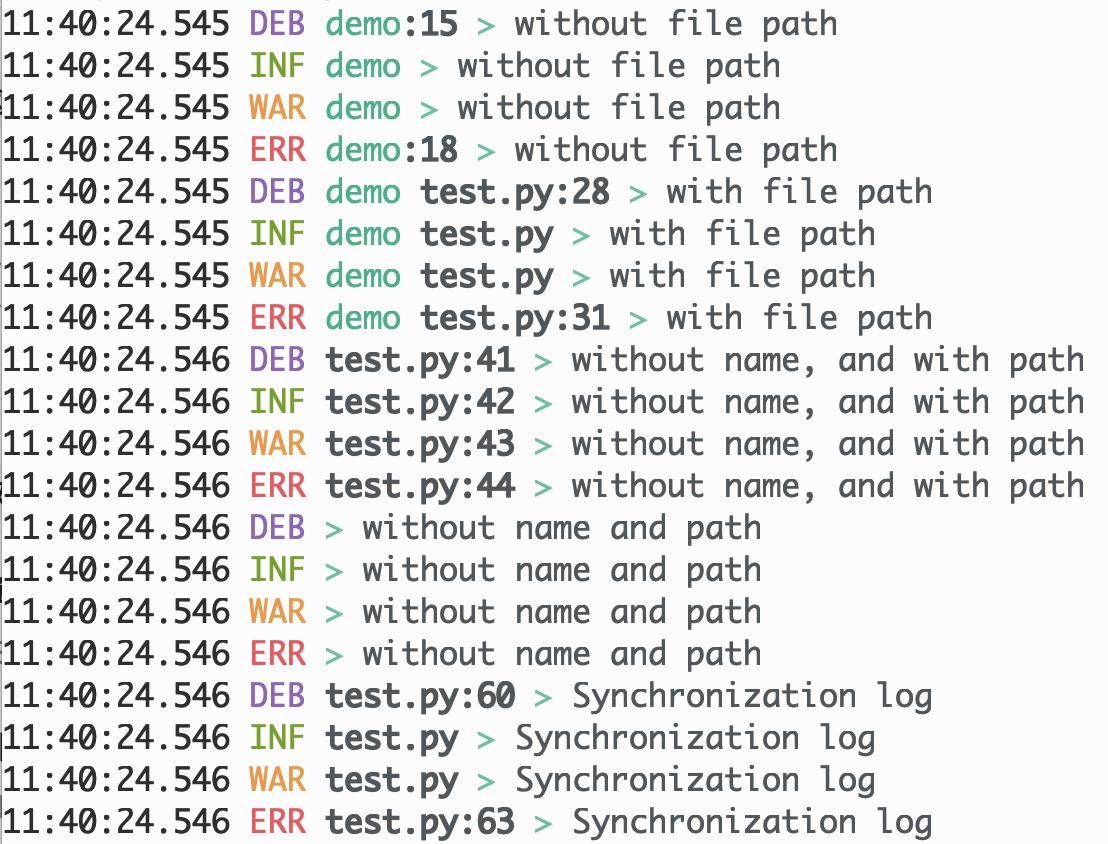A colorful logger for python3.
Project description
Python Colorful Logger
A colorful logger for python3.
How to use
Install
pip install colorful-logger
Usage
1 Default Logger
You can directly use the default logger. Colored logs will be printed on the terminal. The default logger level is warning.
from colorful_logger import logger
with logger:
logger.debug("default logger")
logger.info("default logger")
logger.warning("default logger")
logger.error("default logger")
logger needs to be executed inside a with statement, because this package uses QueueListener for log output. You need to call the start method before using logger to output logs, and call stop after you are done. I encapsulated these two methods inside the with statement. In most cases, there is no need to call start and stop separately.
2 Custom Logger
You can also change the log level, save logs to a file, change the logger name, etc. Logs may not be printed to the terminal.
from colorful_logger import get_logger, DEBUG
def demo_logger(to_file=False):
file = "test_%d.log"
l1 = get_logger(
"demo",
DEBUG,
add_file_path=False,
disable_line_number_filter=False,
file_path=file % 1 if to_file else None,
)
with l1:
l1.debug("without file path")
l1.info("without file path")
l1.warning("without file path")
l1.error("without file path")
l2 = get_logger(
"demo",
DEBUG,
add_file_path=True,
disable_line_number_filter=False,
file_path=file % 2 if to_file else None,
)
with l2:
l2.debug("with file path")
l2.info("with file path")
l2.warning("with file path")
l2.error("with file path")
l3 = get_logger(
None,
DEBUG,
add_file_path=True,
disable_line_number_filter=True,
file_path=file % 3 if to_file else None,
)
with l3:
l3.debug("without name, and with path")
l3.info("without name, and with path")
l3.warning("without name, and with path")
l3.error("without name, and with path")
l4 = get_logger(
None,
DEBUG,
add_file_path=False,
disable_line_number_filter=True,
file_path=file % 4 if to_file else None,
)
with l4:
l4.debug("without name and path")
l4.info("without name and path")
l4.warning("without name and path")
l4.error("without name and path")
l5 = get_logger(None, DEBUG, asynchronous=False)
l5.debug("Synchronization log")
l5.info("Synchronization log")
l5.warning("Synchronization log")
l5.error("Synchronization log")
There may be unexpected behavior when logging outside of the with statement.
Contents of the log file ./test.log (example, inconsistent with the image above):
[90m10:09:33.146[0m [35mDEB[0m [36mdemo[0m[1m:26[0m [96m-[0m without file path
[90m10:09:33.146[0m [32mINF[0m [36mdemo[0m [96m-[0m without file path
[90m10:09:33.146[0m [33mWAR[0m [36mdemo[0m [96m-[0m without file path
[90m10:09:33.146[0m [91mERR[0m [36mdemo[0m[1m:29[0m [96m-[0m without file path
The log file does not contain color logs by default.
To save color logs to a file, set file_colorful to True. In this example, color logs are saved.
The only purpose of the color log file is to view logs in real-time in the terminal:
- Unix
tail -f test.log
# or
cat test.log
- Windows
Get-Content -Path -Wait test.log
Synchronous
If you don't want to log asynchronously, you can create a synchronous logger by passing asynchronous=False. In the example above, l5 is a synchronous logger. When using a synchronous logger, you don't need to wrap the logs in a with statement.
3 Child Logger
After defining a logger, I want to use all the parameters of this logger except for name to output logs. You need to use the child_logger method to generate a child logger. The child logger needs to be executed inside the with statement of the parent logger:
from colorful_logger import get_logger, DEBUG
# parent logger
logger = get_logger(name="sample_logger", level=DEBUG, file_path="./test.log")
with logger:
logger.error("parent error")
l1 = logger.child("l1")
l1.error("l1 error")
l1.fatal("l1 fatal")
The child logger is the same as the parent logger except for the name. It will not log third-party libraries.
Executing the child logger inside the with statement of the parent logger does not mean it has to be called directly inside the with. It can be executed inside a function in the with statement:
# log.py
from colorful_logger import get_logger, DEBUG
logger = get_logger(name="sample_logger", level=DEBUG, file_path="./test.log")
# main.py
from log import logger
from other_file import test
with logger:
test()
# other_file.py
test_logger = logger.child("test_logger")
def test():
test_logger.error("test error")
Project details
Release history Release notifications | RSS feed
Download files
Download the file for your platform. If you're not sure which to choose, learn more about installing packages.
Source Distribution
Built Distribution
Hashes for colorful_logger-0.2.0b5-py3-none-any.whl
| Algorithm | Hash digest | |
|---|---|---|
| SHA256 | c51c0498fd11653a55d9831694aa302f725882d917357cca91782d7cb98358c3 |
|
| MD5 | d81525e44680a870459d241b8bf1bf72 |
|
| BLAKE2b-256 | 4668cb69e496efe246db71b7910aefe0138ae980cd8a35a98b030c76cfb5d8f5 |
















